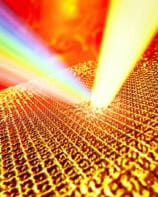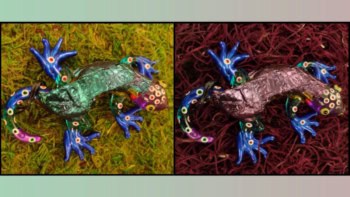
Researchers in Japan have developed pure-blue organic light-emitting diodes (OLEDs) with high efficiency and long lifetimes. They say that this blue light source matches the excellent performance of red and green OLEDs, overcoming one of the major hurdles hindering the development of OLED displays. The team achieved this by stacking two novel emitter molecules on top of each other and splitting the energy conversion and emission processes between them.
OLEDs utilize carbon-containing molecules that emit light in response to an electrical current. They produce vibrant colours and can form thin and even flexible devices. This makes them promising light-source technologies for future displays. While liquid crystal displays (LCD) use liquid crystals to selectively block emission from a filtered backlight covering many pixels, OLED displays use separate red, green and blue emitting pixels that can be individually turned on and off. This produces deeper blacks and reduces power consumption.
However, while red and green OLEDs with excellent performance exist, producing efficient blue OLEDs with long, stable lifespans has proved challenging.
“Stable blue emitters based on a process known as fluorescence are often used in commercial displays, but they suffer from a low maximum efficiency,” Chin-Yiu Chan, of the Center for Organic Photonics and Electronics Research at Kyushu University, tells Physics World. “On the other hand, so-called phosphorescent emitters can achieve an ideal quantum efficiency of 100%, but they generally exhibit shorter operational lifetimes and require an expensive metal such as iridium or platinum.”
Recently research has focused on molecules that emit light using a process known as thermally activated delayed fluorescence (TADF). In most OLED materials, around 75% of the electrical charge produces triplet energy states that do not fluoresce. But TADF molecules can use thermal energy to convert these triplet states into singlet states that do emit light.
In 2019, researchers led by Takuji Hatakeyama, at Kwansei Gakuin University, reported a very efficient TADF material that produces ultrapure-blue light with a narrow emission of just 14 nm. But the molecule, named ν-DABNA, is quite slow at converting triplet states into singlets. This means that it degrades quickly under operation because the high-energy triplet states affect its electro-chemical stability.
Working together, researchers from Kyushu University and Kwansei Gakuin University have now developed a new TADF molecule, as they report in Nature Photonics. This new molecule rapidly converts triplet states to singlets, which helps it maintain its electro-chemical stability. The researchers found that by using this molecule as an intermediate, high-speed energy converter in combination with ν-DABNA, they can drastically improve the lifespan of the latter, while maintaining its narrow emissions.
The new intermediary molecule produces a wide emission spectrum of pure blue. Much of this energy is then absorbed by ν-DABNA, which in turn emits its narrow emission of ultrapure blue. The researchers have dubbed their two-molecule approach hyperfluorescence.
“We achieved longer operational lifetimes at high brightness than previously reported for highly efficient OLEDs having a similar colour purity,” Chan says. “Furthermore, adopting a tandem structure that basically stacks two devices on top of each other effectively doubles the emission for the same electrical current, hence lifetime was nearly doubled at high brightness.”
The researchers estimate that lifespans of 10,000 hours are possible.
Chan tells Physics World that although their results demonstrate one of the best pure-blue OLEDs in the literature, it is still far behind the commercial standard for a blue pixel. He hopes, however, that with continued materials research and device engineering these hyperfluorescence OLEDs can replace current blue fluorescence OLEDs in ultrahigh-definition displays.
“Organic materials used in these OLEDs can be easily prepared in gram to kilogram scale,” Chan adds. “Moreover, vacuum-deposited technique used to fabricate these OLEDs in this paper has been commonly utilized for manufacturing OLED displays in current markets.”



